The data on the number of marriages presented in this special release were obtained from the vital events registered, either timely or belatedly, at the appropriate Office of the City/Municipal Civil Registrar throughout the country and subsequently submitted for encoding to the Office of the Civil Registrar General through the Provincial Statistical Offices (PSOs) of the Philippine Statistics Authority (PSA). The information presented includes provisional vital events that occurred from July to September 2022 based on data files received by the PSA - Civil Registration Service (CRS) from the PSOs and processed as of 31 July 2023. The vital events of Filipinos abroad are not yet included in this release, but Filipinos whose usual residence is abroad and foreign nationals with vital events occurring in the country during the reference period were included in this report. (1) |
(1) Figures are results of actual registrations without any adjustment of under-registration. Civil Registration is a continuous process. Hence, there is a need to establish certain cut-off period.
Number of registered marriages in MIMAROPA increases in the third quarter of 2022
The Philippines was able to register 86,507 marriages for the third quarter of 2022. Of this, MIMAROPA Region had 2,506 registered marriages which corresponds to a 2.9 percent share. Compared to the third quarter of 2021, the MIMAROPA region noted an increase of 36.4 percent for the number of registered marriages during the third quarter of 2021 at 1,837.
On a monthly comparison within the quarter, a total of 880 couples who tied knots was recorded last July 2022 from 629 in the same quarter of 2021; 670 marriages were solemnized in August 2022 from 514 in the same quarter of 2021; and 956 marriages were recorded in September 2022 from 694 marriages in the same quarter of 2021.
Among provinces, Palawan recorded the highest number of registered marriages from July to September 2022 with 934 or 37.3 percent of the total registered marriages in the MIMAROPA Region. But the province of Romblon registered the highest percent change of increase at 67.8 percent from 152 in the third quarter of 2021 to 255 in the third quarter of 2022. (Figure 1)
Figure 1. Number of Registered Marriages by Provinces and Highly
Urbanized City in the MIMAROPA Region:
Third Quarter 2022 and Third Quarter 2021

Source: Philippine Statistics Authority (Data on marriages are those registered at the Office of the City/Municipal Registrars throughout the country and submitted to the Office of the Civil Registrar General; Certificate of Marriage – Municipal Form 97)
Note: Figures are results of actual registration without any adjustment for under registration
Registered Marriages by Province
The province of Marinduque reported an increase of 22.9 percent in the number of registered marriages in the third quarter of 2022 compared to that of the same quarter of 2021. A total of 134 registered marriages were recorded in the third quarter of 2022 while 109 registered marriages were recorded in the third quarter of 2021. The highest registration in the third quarter of 2022 was recorded in the month of July 2022 with 64 registered marriages, followed by the month of September 2022 with 43 registered marriages then by the month of August 2022 with 27 registered marriages. (Figure 2)
Figure 2. Number of Registered Marriages in Marinduque:
Third Quarter 2022 and Third Quarter 2021
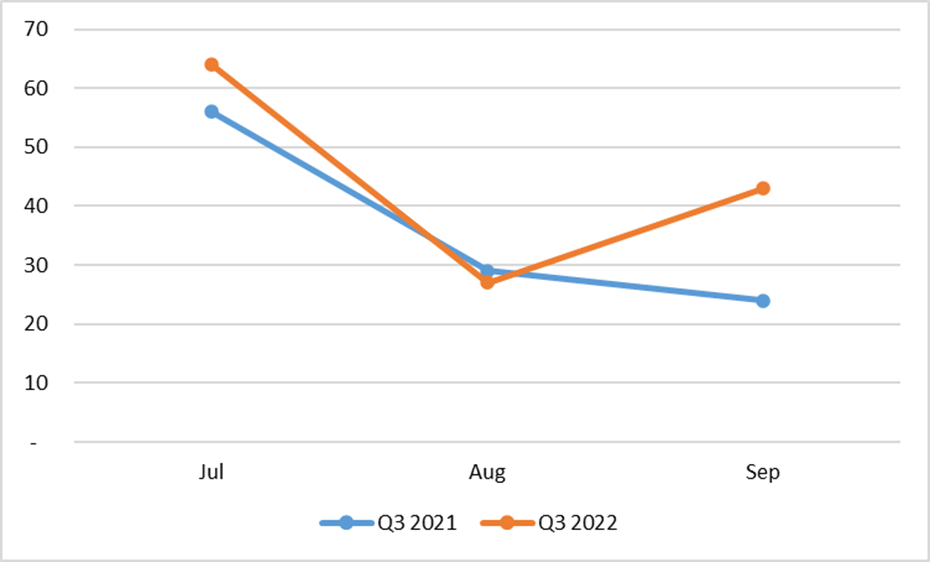
Source: Philippine Statistics Authority (Data on marriages are those registered at the Office of the City/Municipal Registrars throughout the country and submitted to the Office of the Civil Registrar General; Certificate of Marriage – Municipal Form 97)
Note: Figures are results of actual registration without any adjustment for under registration
A total of 214 registered marriages were posted in the third quarter of 2022 in the province of Occidental Mindoro or a 3.9 percent increase. Registered marriages in the province in the third quarter of 2021 were 206. The highest registration of couples who tied the knot in the third quarter of 2022 was recorded in the month of September 2022 with 90 registered marriages, followed by the month of July 2022 with 69 registered marriages then by the month of August 2022 with 55 registered marriages. (Figure 3)
Figure 3. Number of Registered Marriages in Occidental Mindoro:
Third Quarter 2022 and Third Quarter 2021
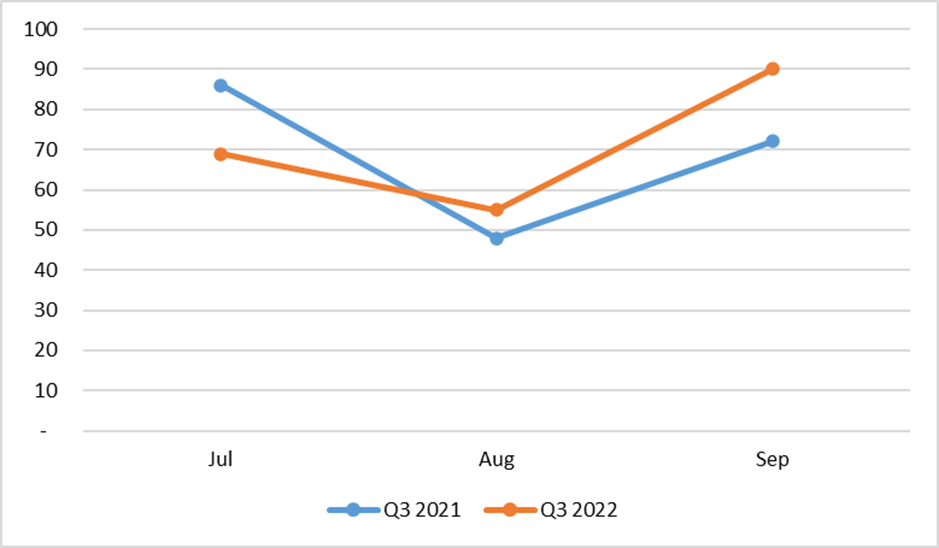
Source: Philippine Statistics Authority (Data on marriages are those registered at the Office of the City/Municipal Registrars throughout the country and submitted to the Office of the Civil Registrar General; Certificate of Marriage – Municipal Form 97)
Note: Figures are results of actual registration without any adjustment for under registration
The provinces of Oriental Mindoro was able to record 660 registered marriages in the third quarter of 2022 or a 22.0 percent increase compared to the third quarter of 2021 with 541 registered marriages. Couples tend to exchange vows in the third quarter of 2022 in the month of September 2022 with 270 registered marriages, followed by the month of July 2022 with 250 registered marriages then by the month of August 2022 with 140 registered marriages. (Figure 4)
Figure 4. Number of Registered Marriages in Oriental Mindoro:
Third Quarter 2022 and Third Quarter 2021
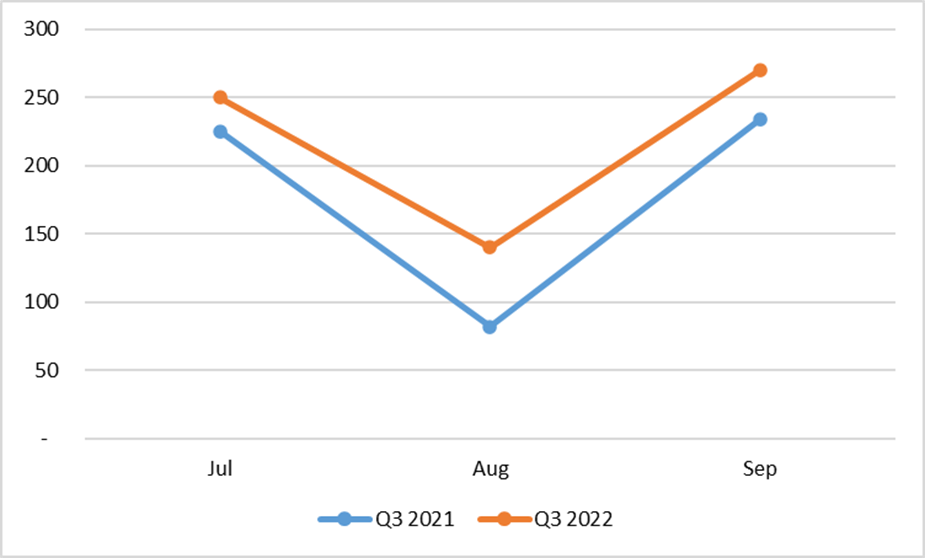
Source: Philippine Statistics Authority (Data on marriages are those registered at the Office of the City/Municipal Registrars throughout the country and submitted to the Office of the Civil Registrar General; Certificate of Marriage – Municipal Form 97)
Note: Figures are results of actual registration without any adjustment for under registration
Among the provinces, Palawan (excluding the City of Puerto Princesa) recorded the highest number of registered marriages in the third quarter of 2022 at 934, an increase of 57.5 percent compared to the third quarter of 2021 with 593 registered marriages. The highest record of solemnizing marriages in the third quarter of 2022 happened in the month of September 2022 with 401 registered marriages, followed by the month of August 2022 with 293 registered marriages then by the month of July 2022 with 240 registered marriages. (Figure 5)
Figure 5. Number of Registered Marriages in Palawan:
Third Quarter 2022 and Third Quarter 2021
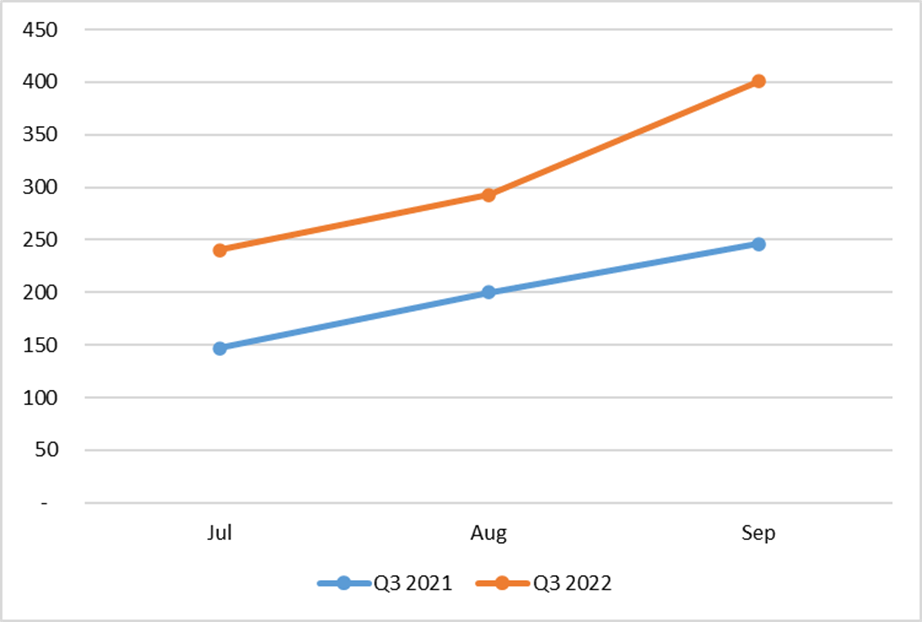
Source: Philippine Statistics Authority (Data on marriages are those registered at the Office of the City/Municipal Registrars throughout the country and submitted to the Office of the Civil Registrar General; Certificate of Marriage – Municipal Form 97)
Note: Figures are results of actual registration without any adjustment for under registration
Marriages in City of Puerto Princesa, a lone highly urbanized city in the MIMAROPA Region, had 309 recorded marriages, a 30.9 percent increase compared to the registered marriages in the third quarter of 2021 at 236. (Figure 6)
Figure 6. Number of Registered Marriages in the City of Puerto Princesa:
Third Quarter 2022 and Third Quarter 2021
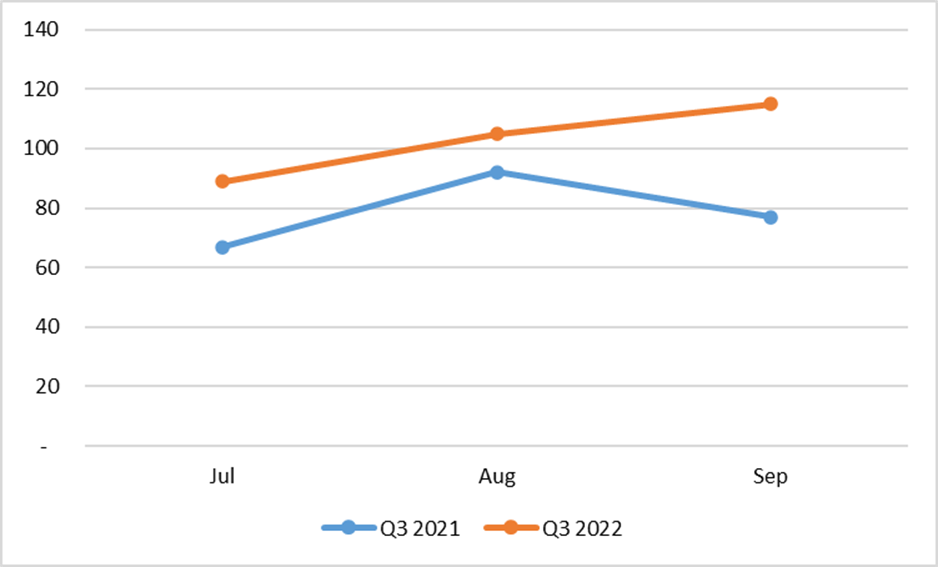
Source: Philippine Statistics Authority (Data on marriages are those registered at the Office of the City/Municipal Registrars throughout the country and submitted to the Office of the Civil Registrar General; Certificate of Marriage – Municipal Form 97)
Note: Figures are results of actual registration without any adjustment for under registration
The number of registered marriages in the province of Romblon for the third quarter of 2022 was 255 or a 67.8 percent increase compared to the third quarter of 2021 with 152. The highest registration in the third quarter of 2022 was recorded in the month of July 2022 with 168 registered marriages, followed by the month of August 2022 with 50 registered live marriages then by the month of September 2022 with 37 registered marriages. (Figure 7)
Figure 7. Number of Registered Marriages in Romblon:
Third Quarter 2022 and Third Quarter 2021
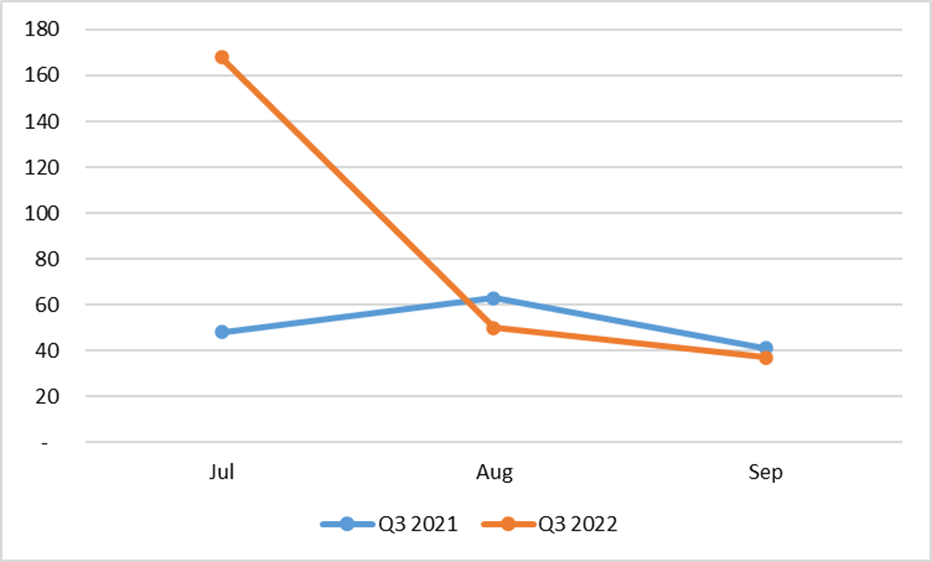
Source: Philippine Statistics Authority (Data on marriages are those registered at the Office of the City/Municipal Registrars throughout the country and submitted to the Office of the Civil Registrar General; Certificate of Marriage – Municipal Form 97)
Note: Figures are results of actual registration without any adjustment for under registration
(SGD) LENI R. RIOFLORIDO
Regional Director
MLLM/RRL/CRC
Technical Notes on Vital Statistics
INTRODUCTION
Vital statistics are derived from information obtained at the time when the occurrences of vital events and their characteristics are inscribed in a civil register.
Vital acts and events are the births, deaths, fetal deaths, marriages, and all such events that have something to do with an individual's entrance and departure from life together with the changes in civil status that may occur to a person during his lifetime. Recording of these events in the civil register is known as vital or civil registration and the resulting documents are called vital records.
STRUCTURE OF VITAL STATISTICS SYSTEM
The production of vital statistics comprised of a system of operations in which the registration of vital events is an important component. The system begins with the registration followed by the processing and controlling of vital records and ends with the compilation and analysis of vital statistics.
Under Commonwealth Act (CA) 591, the Bureau of Census (now Philippine Statistics Authority) is mandated to generate general purpose statistics and to carry out and administer Act No. 3753.
Under the same law, the head of the PSA is also the Civil Registrar General (CRG) who directs and supervises the local civil registration activities in the country. The CRG in this regard is empowered to prepare and issue implementing rules and regulations on civil registration and to prepare and order printed the necessary forms for proper compliance.
The set-up of vital statistics system involves different entities and cuts across different departments and personalities.
For the registration of vital events, the Local Civil Registry Offices (LCROs), which are the registration units in the country and headed by the City/Municipal Civil Registrars (C/MCRs), are under the Local Government Units (LGUs). The hospitals, clinics, rural health units and similar institutions including barangay secretaries, practicing physicians, midwives, nurses, traditional midwives, solemnizing officers from various religious sects and denomination are required to assist in the reporting of vital events for registration at the LCROs. The concerned parents, next of kin, contracting parties, a witness or the person who has full knowledge of the occurrence of the event are also required to report the event, in default of the first mentioned set of informants.
The processing and controlling of vital documents are done at the LCROs and at the PSA Provincial and Central Offices.
The compilation and analysis of vital statistics is taken cared of by the PSA Central Office under the Vital Statistics Division of the Civil Registration and Central Support Office.
THE REGISTRATION METHOD
As mandated in Act 3753, all vital events that marked the entry and departure of a person in his lifetime and the changes in his/her civil status shall be registered. The registration method is defined as the continuous, permanents and compulsory recording of the occurrences and characteristics of vital events, primarily for their value as legal documents and secondary for their usefulness as a source of statistics.
Place where to register the event
As a general rule, the place of registration is the LCRO of the city of municipality where the vital events occur.
Out of town reporting of vital event occurs when the documents presented to the civil registrar of LCRO, which is not the place of occurrence, not for registration but to be forwarded to the civil registrar of LCRO where the event occurred and where it should be registered.
Forms to use
The civil register consists of certificates and the registry book. It also includes the actual copies of the registrable court decisions and the legal instruments concerning the civil status of persons. The certificates are loose-leaf forms in a set of four copies except for the Certificate of Foundling which is in a set of three.
Person who will report the event
The informant is the one who reports the event for registration and who gives information to be recorded in the civil register.
In case of live birth, the law requires the hospital or clinic administrator or his representative if the birth occurred in the hospital or clinic. If the birth occurred elsewhere, the attendant who may either be a physician, nurse, license midwife or traditional birth attendant makes the report. In default of the hospital authority, or the attendant, the responsibility of reporting the births devolves upon either or both parents or upon a person who has full knowledge of the facts of birth and filiation of the child.
Period when to report the event
Live births shall be reported for registration to C/MCR not later than thirty (30) days from the date of birth.
Any report made to the LCROs beyond the reglementary period are considered late and can be entered only in the civil register after the informant complies with the requirements for delayed registration.
Operative Act of Registration
The C/MCR sees to it that appropriate form it used; form is properly and completely filled-up; and proper attachments are submitted. In case, the entries are found incomplete, the C/MCR has to require the person concerned to fill up the document completely or to correct the entries.
When the document is accepted for registration, the date of receipt is recorded in the space provided and the documents received for the day are entered immediately in the appropriate civil registry book, assigning therein the corresponding registry number. After registration entry/entries found erroneous can only be corrected through RA 9048, except sex, nationality, age and status which require court approval.
Distribution of registered documents
Upon registration, the C/MCR distributes the copies accordingly: the first copy to the informant; the second copy to the CRG; the third copy shall be retained by the LCRO; and the fourth copy to the attendant or solemnizing officer, as the case may be. The CRG copy is the source of vital statistics published in this report.
DEFINITION OF TERMS AND CONCEPTS
Significant terminologist and descriptions in the foregoing highlights and tables are defined below. Included are some items found in the certificates and summary measure used in describing the facts of events.
Live Birth is a complete expulsion or extraction from its mother of a product of conception, irrespective of the duration of the pregnancy, which after such separation, breathes or shows any other evidence of life, such as beating of the heart, pulsation of the umbilical cord, or definite movement of voluntary muscles, whether or not the umbilical cord has been cut or the placenta is attached; each product of such a birth is considered liveborn.


